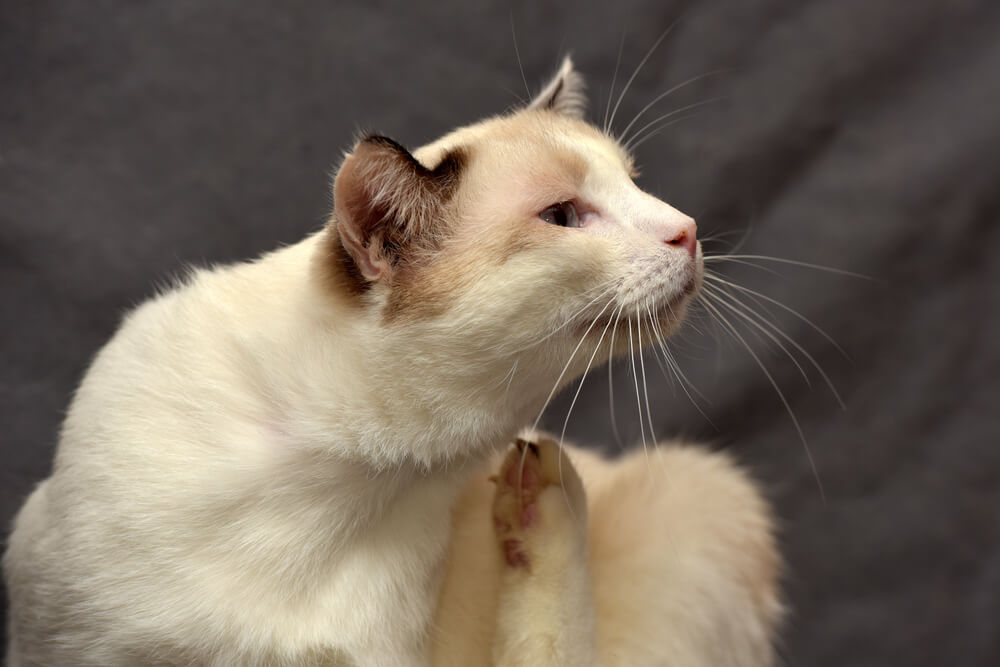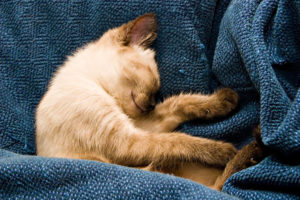Fleas are parasitic insect that digests the blood of mammals. They also feed on other insects and can even digest plant material and animal dander, pollen, and fungal spores.
Adult fleas can be up to 4mm long. Their bodies are laterally compressed, which allows them to move swiftly through hair or feathers on their host. Their bodies are covered in hard, pale plates of the exoskeleton, which protect them from being crushed by their hosts or abraded while moving through hair or feathers.
It is the female that sucks blood. The larvae feed on various organic matter, including adult flea feces, dead skin cells, and other debris found in the host’s environment. After they have gone through three larval stages and one pupal stage, they become adults in two to twelve days, or up to two months depending on environmental conditions such as humidity and temperature.
One female cat can lay over 2,000 eggs during its life span of about one year. The female flea will devour around 15 times her own weight in blood during her adult life.
Fleas can jump long distances; the record is 100 inches (254 cm). They are drawn to warmth and carbon dioxide which is why they will often attempt to feed on their host’s face, neck, or legs.
Adult female cat fleas will usually flee the host body and burrow into carpet, upholstery, and other nesting areas to lay eggs. Cat flea larvae then feed on dried blood in adult feces which can also be found in or around floorboards and bedding inside of the home.
Since they do not fly, ticks climb up long grass blades or other tall vegetation and wait for a host, such as a dog or a cat to pass by. They then grab onto the fur and begin feeding on the host’s blood.
Ticks can be very difficult to remove once they have attached themselves to their host because of their hard exoskeleton. It is important not to pull them out with your fingers due to a good chance of the tick’s mouthparts remaining in the skin.
Ticks are vectors for disease, which is why it is important to get rid of fleas on cats before they have a chance to attach themselves to their host.
When you notice that your cat has fleas, start with treating your furry friend first. You can use oral, topical, or environmental treatments.
Make sure to treat both your cat and its environment with the appropriate type of treatment. For example, you should not use a flea collar on top of an insect fogger or vice versa.
Your cat’s bedding should also be washed weekly since eggs and larvae can reside in the fibers of bedding or furniture.
Next, get a flea comb and start removing the adult fleas from your cat’s body. Using a soapy mixture will expedite this process. A white sheet can be used to trap the larvae and pupae found on the floor of your house while using an insect fogger to remove any remaining adults and eggs.
If your cat is heavily infested, you may need to bring them to a veterinary clinic where they will be given an injection of Ivermectin. This will kill off any eggs or larvae that have been left behind during the course of treatment and should be repeated in a month’s time if necessary.
Flea collars, shampoos, and other topical applications should be used in accordance with your veterinarian’s advice. Environmental treatments such as foggers or heaters should also be applied according to the manufacturer’s instructions.
If you know that there are ticks on your cat, carefully remove them using fine-tipped tweezers. Clean the area with antiseptic and monitor for infections.
If you find any ticks on your cat, change the bedding in your cat’s home to remove any eggs or larvae that may remain. You can also use an insect fogger after removing ticks to further prevent fleas from coming back.
Flea bites are very common especially in areas where there is a high population of cats, rodents, or both. Fleas are tiny insects that are usually black or dark brown in color. They have six legs, ahead, and an abdomen. The head has two small antennae protruding from the front.
What home remedy kills fleas on cats?
There are a few different options for you to choose from. The following home remedies can be helpful in getting rid of fleas on cats:
1. Salt and lemon juice mixture
This one is known as a good cat-friendly remedy that often works quickly. In a spray bottle, mix together about ½ cup of salt with the juice of two lemons or limes. Spray this solution on your cat’s coat, making sure to avoid the cat’s eyes and nose. If it gets into their eyes or nose, they may be uncomfortable and feel a burning sensation so keep an eye on them after applying this treatment. You should see some dead fleas coming off immediately but if not, have patience – the longer you let this sit on your cat’s coat, the better.
2. Diatomaceous earth
Diatomaceous earth is a great way to get rid of fleas on cats and more. This powdery substance has very sharp edges that cut into insects’ exoskeletons and dehydrates them from the inside out. To use this method on your cat, simply mix the diatomaceous earth with a little bit of water so it can be sprinkled onto their fur evenly. Then brush or comb some of it through their fur to ensure full coverage and let sit for about an hour before bathing. If you don’t have time for an hour-long treatment session, feel free to give your pet a shorter bath instead using any quality shampoo you want.
3. Essential oils and water spray
The next home remedy for killing fleas on cats is a mixture of essential oils and water in a spray bottle. You will need about 20 to 30 drops total (10 each of tea tree, lavender, and eucalyptus oil). Pour the drops into the water and shake it up to mix well before spritzing your cat’s fur generously with it. Allow to sit for about an hour before brushing the hair or giving the cat a bath as usual. This works great because essential oils are natural substances that you can use without fear of harming your pet – but be aware that they do not kill adult fleas so you’ll need something else for that purpose as well.
4. Essential oils and baking soda
Another essential oils home remedy for fleas on cats is mixing a few drops of your chosen oil with some baking soda. The ratio to use here is about 2 tbsp. of baking soda for every 5 drops or so of essential oil – this will be enough to make a paste that you can rub onto the fur very thoroughly. Allow this mixture to sit on the cat’s fur for an hour before bathing them as usual. Be aware though that not all pets enjoy these types of treatments – if your cat seems uncomfortable, stop immediately.
5. Flea collar powerhouse
A great natural method for killing adult fleas on cats is using a flea collar powerhouse like diatomaceous earth, cedarwood shavings, or neem oil. These substances are known to repel insects like mosquitoes and lice but can also get rid of fleas (and their eggs) when they come in contact with them. Use these substances by rubbing onto the cat’s fur for about an hour before bathing your pet. Or you can also put some on their collar to stop any adult fleas that might be journeying toward your home while keeping your pet protected at the same time.
6. Spray it away
The final method for killing adults fleas on cats is using a spray solution that will allow you to cover your cat’s coat thoroughly without having direct contact with them. Combine 10 drops each of rosemary, thy, and cedarwood essential oils with 2 cups of water and spray this solution all over your cat’s fur, making sure to avoid their face. Allow the powder to sit for an hour before bathing your pet as usual – this mixture will not kill adult fleas, but it will repel them from getting too close.
7. Shampoo or dip
If you have a lot of pets that need flea treatment, one great solution is simply using a shampoo or dip treatment on them all at once so they can enjoy quick relief from itching and scratching. In fact, you might want to think about doing this regularly yourself – every two weeks is very effective at controlling adult fleas on cats because it keeps their population from building up. There are a variety of shampoos, dips, and rinses that you can find for this purpose at any pet supply store.
8. Flea comb
Of course one of the most effective methods to use when trying to kill adult fleas on cats is a natural cat flea comb. This item has tiny little teeth that are very good at removing eggs from their fur so they can’t hatch into new adults. For best results, get a high-quality metal flea comb like the Safari brand which will leave nothing behind but dead insects in your hand or waste bin before being tossed out. You will need to treat for about three weeks in a row if you want to completely eliminate these parasites from your home – but it’s worth it!
9. Flea shampoo
Using a good cat flea shampoo is also one of the best ways to eliminate adult fleas on cats successfully. Keep in mind that many store-bought shampoos are very toxic and should never be used for this purpose – look for organic, natural brands like Sakural before attempting this method. Comb through your cat’s fur very thoroughly after using the shampoo and allow them to dry off before putting on any other treatment or allowing them outside again.
How did my indoor cat get fleas?
Indoor cats can get fleas from other pets that can jump very high or by going outside and coming into contact with them that way. If a pet has been outdoors, it is a good idea to treat the entire home for these parasites by using natural methods like Neem oil, borax, or cedar shavings. You should also consider fencing your property so that your cat cannot escape.
How do I prevent my indoor cat from getting fleas?
You should keep pets who have recently come indoors away from any other animals until they have been treated for adult fleas on cats – especially if you have outdoor pets or livestock that might carry them in. You should also take care to vacuum every corner of your flooring at least every other day to get rid of any errant parasites before they have a chance to take hold in your home. In addition, keep the skin and fur around your cat’s neck well-groomed at all times so that it is easier to spot parasites if they should come near.
What can kill fleas instantly?
One of the best remedies to prevent and kill fleas instantly is a mixture of 1 tablespoon vinegar, 10 drops of lavender oil, and 2 cups water. You can pour this solution directly into your pet’s fur while avoiding their face, or use it in a spray bottle for ease of application. It will not only get rid of adult fleas on cats but will also leave your cat smelling fresh, clean, and full of life.
You may also want to try using cedar oils around your home if you have trouble with these insects returning time after time – just keep them away from cats! If all else fails, consider consulting a veterinarian about prescription treatments that will ensure no pests survive in your house on your pet where they might continue to procreate.
Reference List:
- http://www.getridofthings.com/
- http://www.indoorpet.osu.edu/
- http://www.wikihow.com/
- http://www.ehow.com/
- http://householditemsthality.weeb





